H1.07Ti1.73O4-Derived Porous Plate-like TiO2 as High-Performance Bifunctional Anodes for Lithium- and Sodium-Ion Batteries
Abstract
1. Introduction
2. Experiment
2.1. Preparation of Porous Plate-like TiO2
2.2. Characterization
2.3. Preparation of the Electrode
2.4. Electrical Measurement
3. Results
3.1. Lithium-Ion Battery Performance Testing and Analysis
3.2. Sodium-Ion Battery Performance Testing and Analysis
4. Conclusions
Supplementary Materials
Author Contributions
Funding
Data Availability Statement
Conflicts of Interest
References
- Li, S.; Wang, K.; Zhang, G.; Li, S.; Xu, Y.; Zhang, X.; Zhang, X.; Sun, X.; Ma, Y.; Zheng, S. Fast Charging Anode Materials for Lithium-Ion Batteries: Current Status and Perspectives. Adv. Funct. Mater. 2022, 32, 2200796. [Google Scholar] [CrossRef]
- Wang, R.; Wang, L.; Liu, R.; Li, X.; Wu, Y.; Ran, F. “Fast-Charging” Anode Materials for Lithium-Ion Batteries from Perspective of Ion Diffusion in Crystal Structure. ACS Nano 2024, 18, 2611–2648. [Google Scholar] [CrossRef]
- Yang, Z.-Z.; Zhang, C.-Y.; Ou, Y.-Q.; Su, Z.-K.; Zhao, Y.; Cong, H.-J.; Ai, X.-P.; Qian, J.-F. Amorphous Sb/C composite with isotropic expansion property as an ultra-stable and high-rate anode for lithium-ion batteries. Rare Met. 2024, 43, 2039–2052. [Google Scholar] [CrossRef]
- Siti Norhasanah, S.; Hwa-Young, Y.; Jeevan, K.; Ye-Chong, M.; Gangasagar Sharma, G.; Seung-Ju, Y.; Yong Ju, K.; Sejung, K.; Bong-Hyun, J.; Won-Yeop, R. Machine Learning-Assisted Fabrication of PCBM-Perovskite Solar Cells with Nanopatterned TiO2 Layer. Energy Environ. Mater. 2024, 7, 219–226. [Google Scholar] [CrossRef]
- Yu, L.; Yu, X.Y.; Lou, X.W. The Design and Synthesis of Hollow Micro-/Nanostructures: Present and Future Trends. Adv. Mater. 2018, 30, 1800939. [Google Scholar] [CrossRef] [PubMed]
- Wang, G.; Lei, H.; Liu, Z.; Yuan, Z.; Li, L.; Zhan, Z.; Wang, X. An oxygen-deficient Ge/GeO2/C anode for lithium ion batteries with enhanced reversible energy storage performance. J. Power Sources 2025, 632, 236319. [Google Scholar] [CrossRef]
- Hyeon, C.-W.; Kim, B.; Kim, C.W.; Li, L.; Chung, C.-Y.; Chun, S.-E. Thin-shelled hollow mesoporous TiO2 spheres with less tortuosity as fast-charging anode. Compos. Part B 2024, 286, 111760. [Google Scholar] [CrossRef]
- Wang, G.; Gao, W.; Zhan, Z.; Li, Z. Defect-engineered TiO2 nanocrystals for enhanced lithium-ion battery storage performance. Appl. Surf. Sci. 2022, 598, 153869. [Google Scholar] [CrossRef]
- Hsu, H.-J.; Li, C.-C. TiO2-based microsphere with large pores to improve the electrochemical performance of Li-ion anodes. Ceram. Int. 2021, 47, 12038–12046. [Google Scholar] [CrossRef]
- Liu, C.; Zhao, P.; Lu, K.; Zhang, C.; Xia, X.; Lei, W.; Guo, Q.; Hao, Q.; Han, S. Facilitating Highly Reversible Li-Ion Storage of MoSe2-TiO2-MXene via Double Heterostructures. Adv. Funct. Mater. 2024, 34, 2401392. [Google Scholar] [CrossRef]
- Ke, J.; Li, M.; Hu, A.; Gao, P.; Liu, J.; Chen, S.; Xiao, P.; Xu, C. Tailored Design Ti4+ Coordination via Coplanar Carboxyl and Hydroxyl Groups Toward High Purity TiO2(B) with Ultrafast Li+ Storage. Adv. Funct. Mater. 2024, 34, 2315218. [Google Scholar] [CrossRef]
- Su, Z.; Liu, J.; Li, M.; Zhu, Y.; Qian, S.; Weng, M.; Zheng, J.; Zhong, Y.; Pan, F.; Zhang, S. Defect Engineering in Titanium-Based Oxides for Electrochemical Energy Storage Devices. Electrochem. Energy Rev. 2020, 3, 286–343. [Google Scholar] [CrossRef]
- Yao, T.; Wang, H.; Ji, X.; Zhang, Q.; Shi, J.W.; Han, X.; Cheng, Y.; Wang, D.; Meng, L. Introducing Hybrid Defects of Silicon Doping and Oxygen Vacancies into MOF-Derived TiO2–X@Carbon Nanotablets Toward High-Performance Sodium-Ion Storage. Small 2023, 19, 2302831. [Google Scholar] [CrossRef]
- Zhang, D.; Xu, H. Nickel modified TiO2/C nanodisks with defective and near-amorphous structure for high-performance sodium-ion batteries. Battery Energy 2024, 3, 20230032. [Google Scholar] [CrossRef]
- Chen, J.; Fu, Y.; Sun, F.; Hu, Z.; Wang, X.; Zhang, T.; Zhang, F.; Wu, X.; Chen, H.; Cheng, G.; et al. Oxygen vacancies and phase tuning of self-supported black TiO2-X nanotube arrays for enhanced sodium storage. Chem. Eng. J. 2020, 400, 125784. [Google Scholar] [CrossRef]
- Xu, X.; Zhou, T.; Sun, Q.; Lu, Y. Advanced keratin-coated polypropylene composite current collectors: Design for in-situ, integrated flexible temperature sensing in lithium-ion batteries. Chem. Eng. J. 2025, 519, 165276. [Google Scholar] [CrossRef]
- Kong, X.; Su, Y.; Xing, C.; Cheng, W.; Huang, J.; Zhang, L.; Ouyang, H.; Feng, Q. Facile synthesis of porous TiO2/SnO2 nanocomposite as lithium ion battery anode with enhanced cycling stability via nanoconfinement effect. Chin. Chem. Lett. 2024, 35, 109428. [Google Scholar] [CrossRef]
- Lu, S.; Shang, Y.; Zheng, W.; Huang, Y.; Wang, R.; Zeng, W.; Zhan, H.; Yang, Y.; Mei, J. TiO2(B) nanosheets modified Li4Ti5O12 microsphere anode for high-rate lithium-ion batteries. Nanotechnology 2022, 33, 245404. [Google Scholar] [CrossRef]
- Ge, H.; Cui, L.; Zhang, B.; Ma, T.-Y.; Song, X.-M. Ag quantum dots promoted Li4Ti5O12/TiO2 nanosheets with ultrahigh reversible capacity and super rate performance for power lithium-ion batteries. J. Mater. Chem. A 2016, 4, 16886–16895. [Google Scholar] [CrossRef]
- Huang, H.; Zhang, W.K.; Gan, X.P.; Wang, C.; Zhang, L. Electrochemical investigation of TiO2/carbon nanotubes nanocomposite as anode materials for lithium-ion batteries. Mater. Lett. 2007, 61, 296–299. [Google Scholar] [CrossRef]
- Wang, J.; Bai, Y.; Zhang, W.F.; Wu, M.; Yin, J. Preparation and electrochemical properties of TiO2 hollow spheres as an anode material for lithium-ion batteries. J. Power Sources 2009, 191, 614–618. [Google Scholar] [CrossRef]
- Kim, H.; Kim, M.C.; Choi, S.; Moon, S.H.; Kim, Y.S.; Park, K.W. Facile one-pot synthesis of Ge/TiO2 nanocomposite structures with improved electrochemical performance. Nanoscale 2019, 11, 17415–17424. [Google Scholar] [CrossRef]
- Xu, Y.; Zhou, M.; Wen, L.; Wang, C.; Zhao, H.; Mi, Y.; Liang, L.; Lei, Y.; Fu, Q.; Wu, M. Highly Ordered Three-Dimensional Ni-TiO2 Nanoarrays as Sodium Ion Battery Anodes. Chem. Mater. 2015, 27, 4274–4280. [Google Scholar] [CrossRef]
- Li, Y.; Sun, S.; Tang, J.; Han, S.; Yang, Y.; Xing, J.; Zong, L.; Wang, L.; Li, B. Volume expansion restriction by TiO2 structural unit in silicon anodes with yolk-shell structure for lithium-ion batteries. Nano Res. 2025, 18, 94907474. [Google Scholar] [CrossRef]
- Wang, J.; Cheng, C.; Zhang, J.; Yang, J.; Wang, Z.; Li, L.; Bai, W.; Richard, Y.K.K. Mechanically robust and fireproof separator for safer lithium-ion batteries with enhanced thermal stability. J. Power Sources 2025, 641, 236905. [Google Scholar] [CrossRef]
- Helaley, A.; Liang, X. Solid-state sodium-ion batteries with composite polymer electrolytes and ALD-modified Na0.7MnO2 cathodes. Chem. Eng. J. 2025, 514, 163173. [Google Scholar] [CrossRef]
- Li, C.; Pan, Q.; Jiang, W.-J.; Liu, Z.-Y.; Chen, L. Titanium dioxide-based materials for alkali metal-ion batteries: Safety and development. J. Power Sources 2025, 634, 236492. [Google Scholar] [CrossRef]
- Zhang, W.; Yao, F.; Al Samarai, M.; Feng, Q. Mesoporous anatase TiO2 mesocrystal for high-performance photocatalysis and lithium-ion batteries. Nanoscale 2025, 17, 9418–9426. [Google Scholar] [CrossRef]
- Liu, X.; Zhou, J.; Zhu, G.; Li, J.; Zhang, H. Phosphorus-doped amorphous TiO2/C interface enables hierarchical SEI formation on micron-sized SiO anodes for ultra-stable lithium-ion batteries. J. Mater. Chem. A 2025, 13, 19429–19439. [Google Scholar] [CrossRef]
- Cheng, W.; Feng, Q.; Guo, Z.; Chen, G.; Wang, Y.; Yin, L.; Li, J.; Kong, X. Electrochemical reaction mechanism of porous Zn2Ti3O8 as a high-performance pseudocapacitive anode for Li-ion batteries. Chin. Chem. Lett. 2022, 33, 4776–4780. [Google Scholar] [CrossRef]
- Luebke, M.; Shin, J.; Marchand, P.; Brett, D.; Shearing, P.; Liu, Z.; Darr, J.A. Highly pseudocapacitive Nb-doped TiO2 high power anodes for lithium-ion batteries. J. Mater. Chem. A 2015, 3, 22908–22914. [Google Scholar] [CrossRef]
- Cui, L.; Hou, Y.; Sun, S.; Wang, M.; Wang, Y.; Li, G.; Yu, K. Nanoflower-shaped multivariate heterogeneous composites with multiple redox sites for high-performance lithium-ion batteries. J. Energy Storage 2025, 132, 117903. [Google Scholar] [CrossRef]
- Song, Z.; Zhou, Q.; Zeng, J.; Zhang, W.; Zhuang, S.; Luo, H.; Lu, M.; Li, X. Lithium-philic organic polymer@mixed-phase TiO2 core-shell nanospheres for high-rate and long-cyclic performance in liquid/solid-state lithium-ion batteries. J. Power Sources 2025, 626, 235782. [Google Scholar] [CrossRef]
- Du, X.Y.; He, W.; Zhang, X.D.; Yue, Y.Z.; Liu, H.; Zhang, X.G.; Min, D.D.; Ge, X.X.; Du, Y. Enhancing the electrochemical performance of lithium ion batteries using mesoporous Li3V2(PO4)(3)/C microspheres. J. Mater. Chem. 2012, 22, 5960–5969. [Google Scholar] [CrossRef]
- Yan, Z.; Fan, S.; Zou, X.; Jiang, Q.; Tang, D.; Lan, K.; Li, J.; Lin, Y.; Huang, Z.; Peng, D.-L.; et al. Scalable synthesis of anatase TiO2 nano-in-micro spheres for hybrid sodium-ion capacitors. Chem. Eng. J. 2025, 519, 165100. [Google Scholar] [CrossRef]
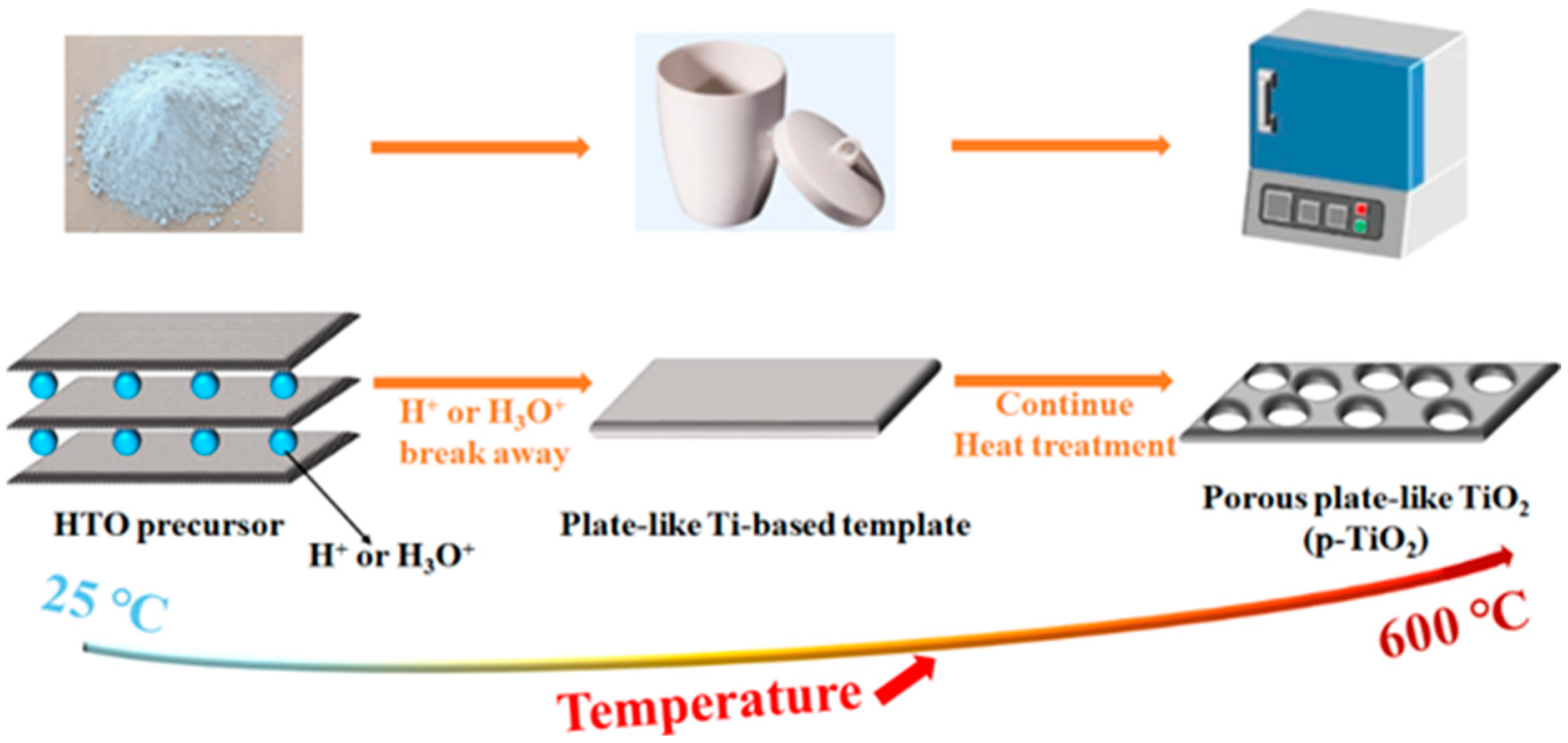
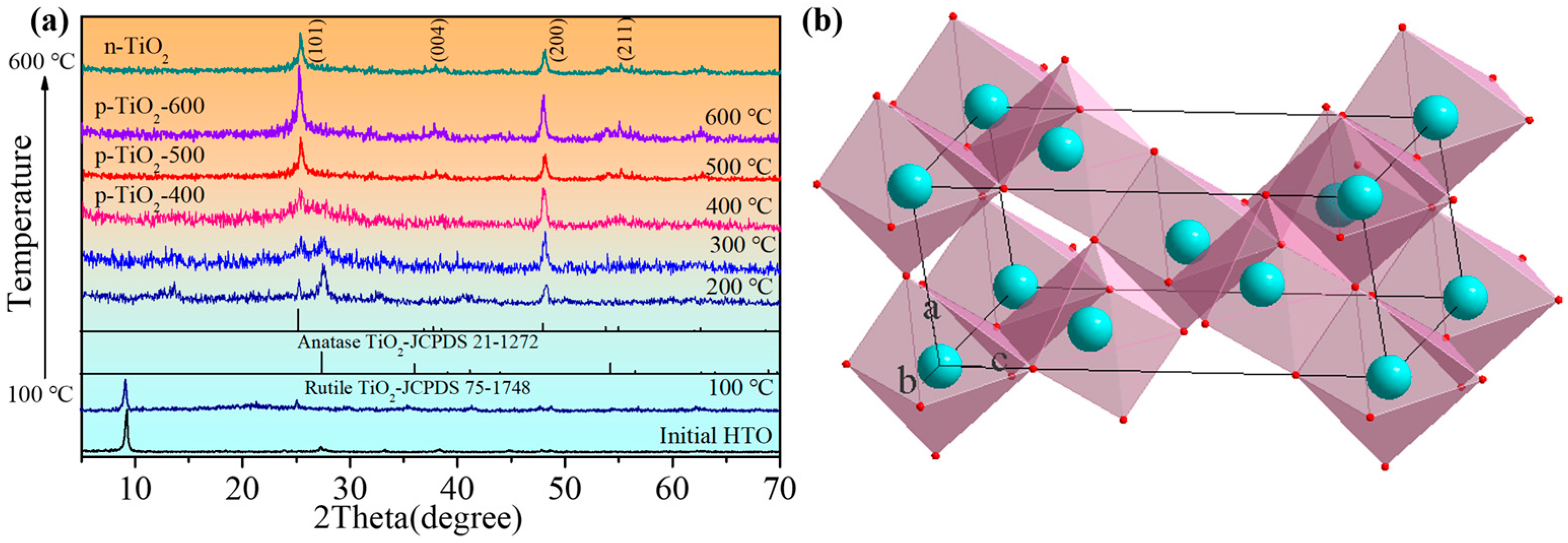
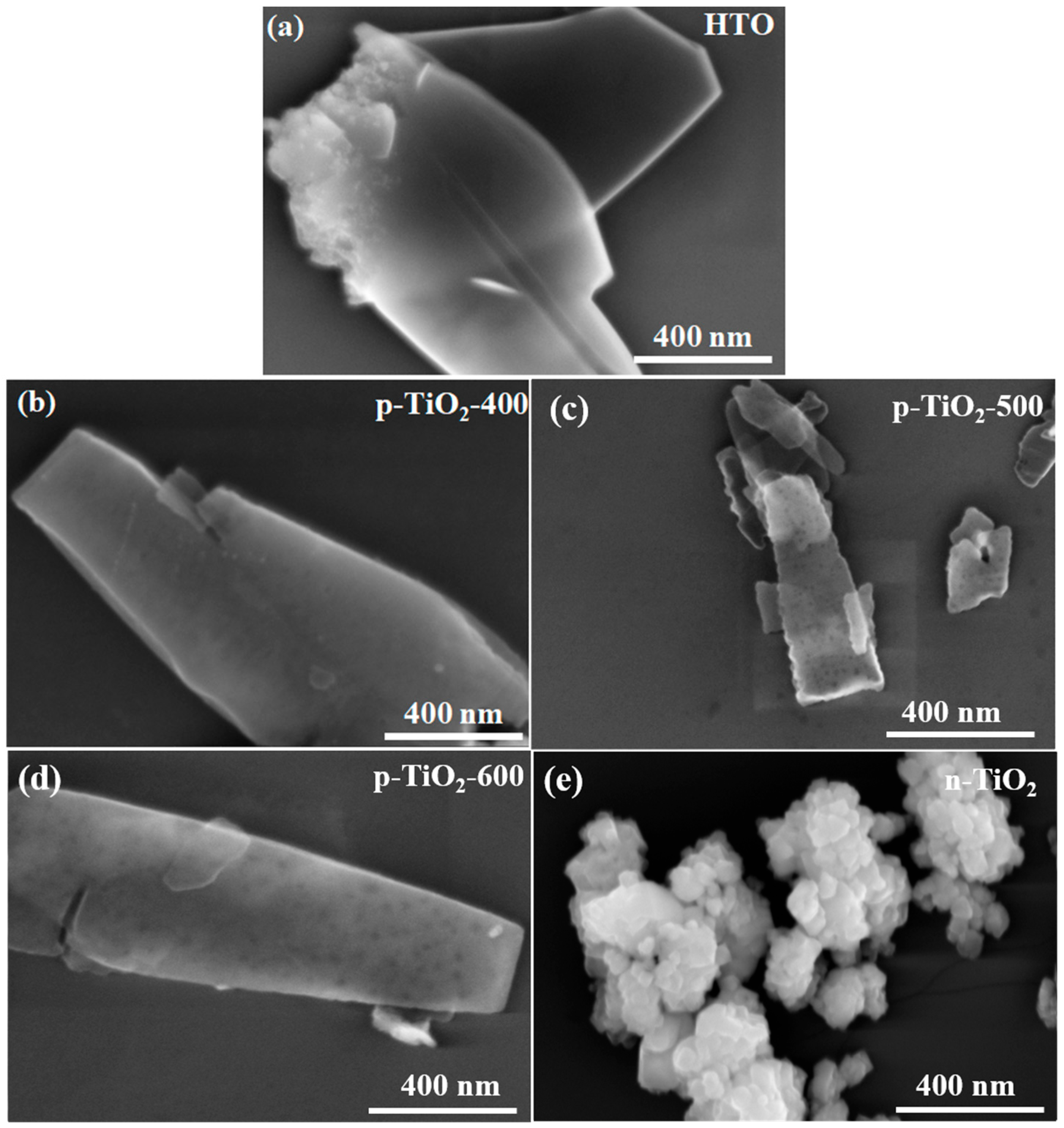

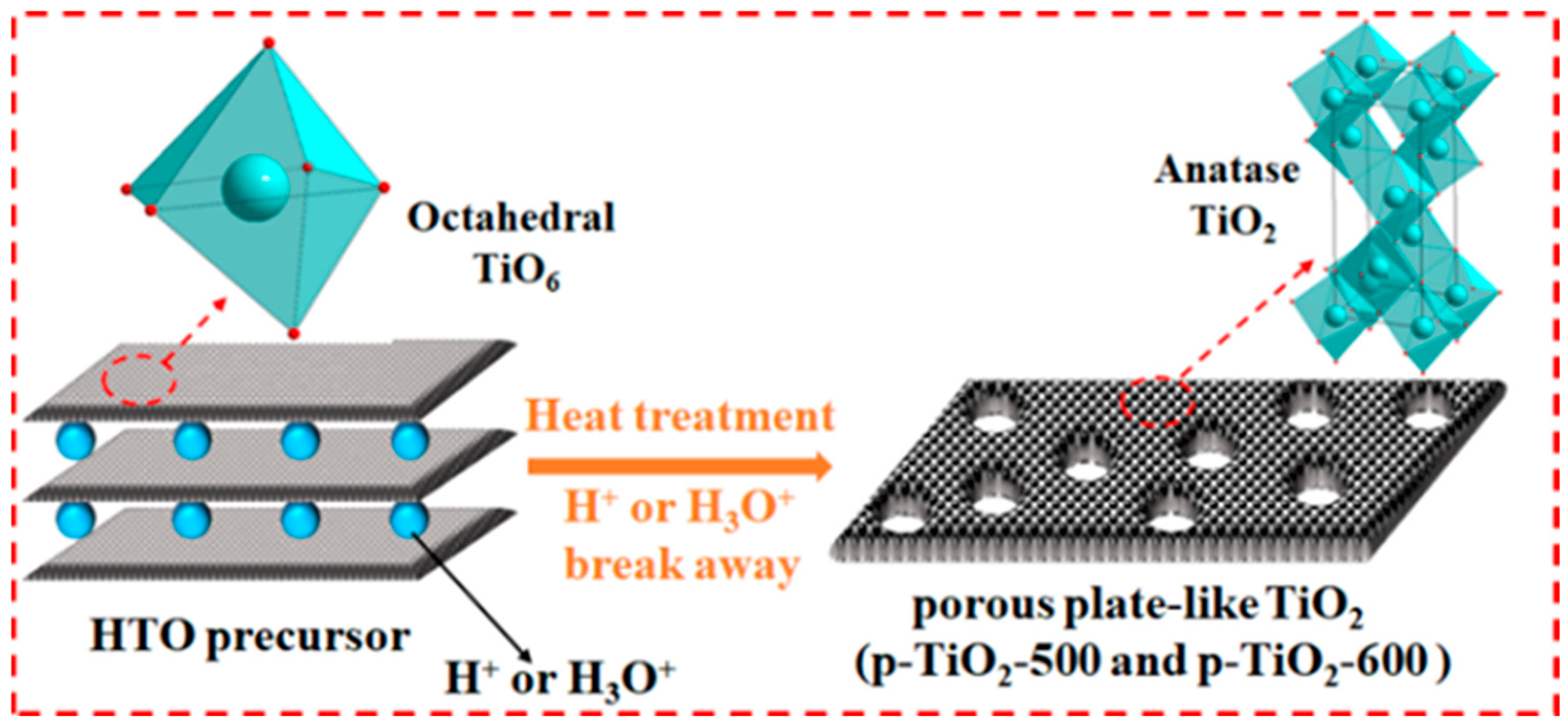
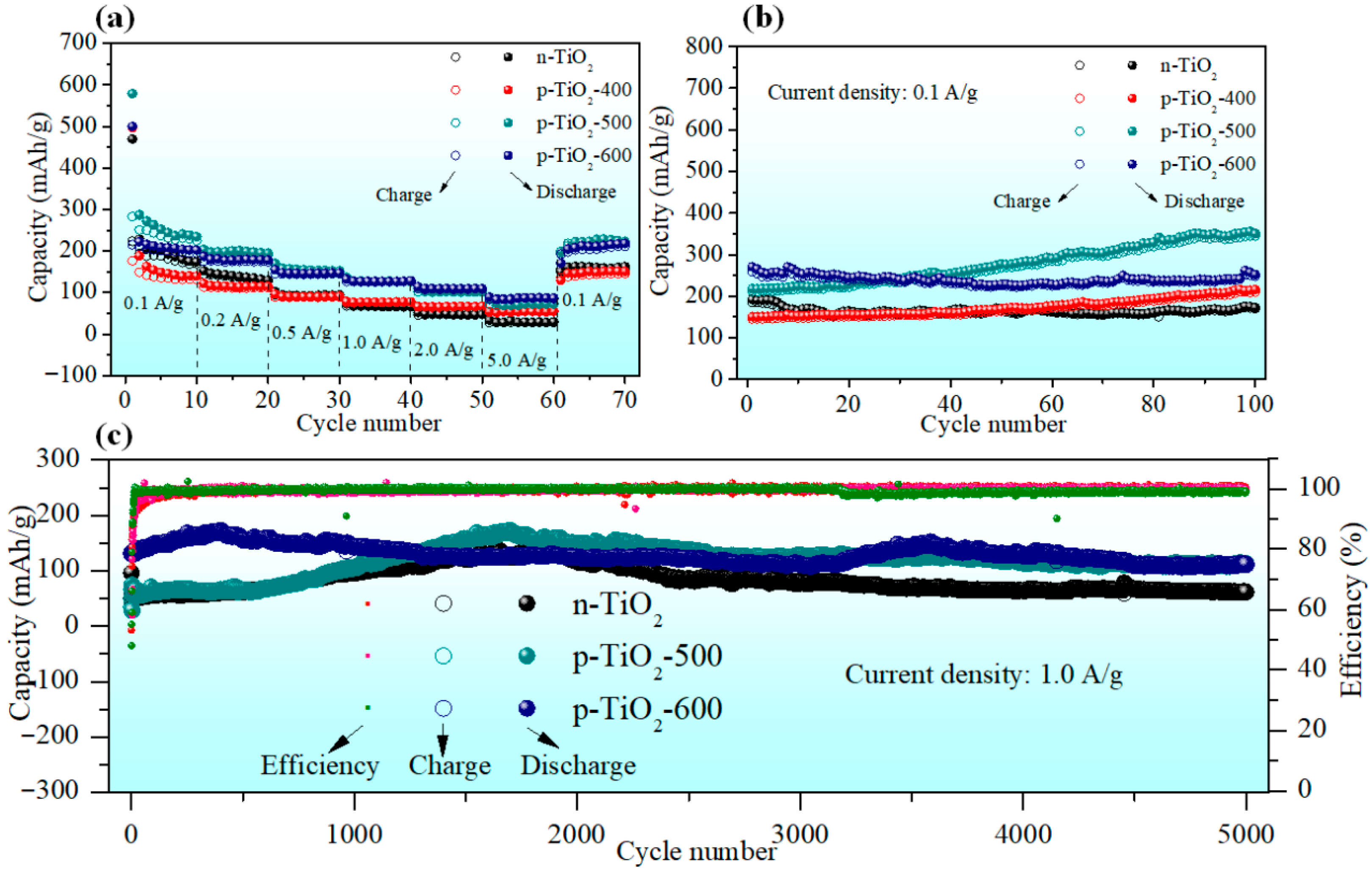

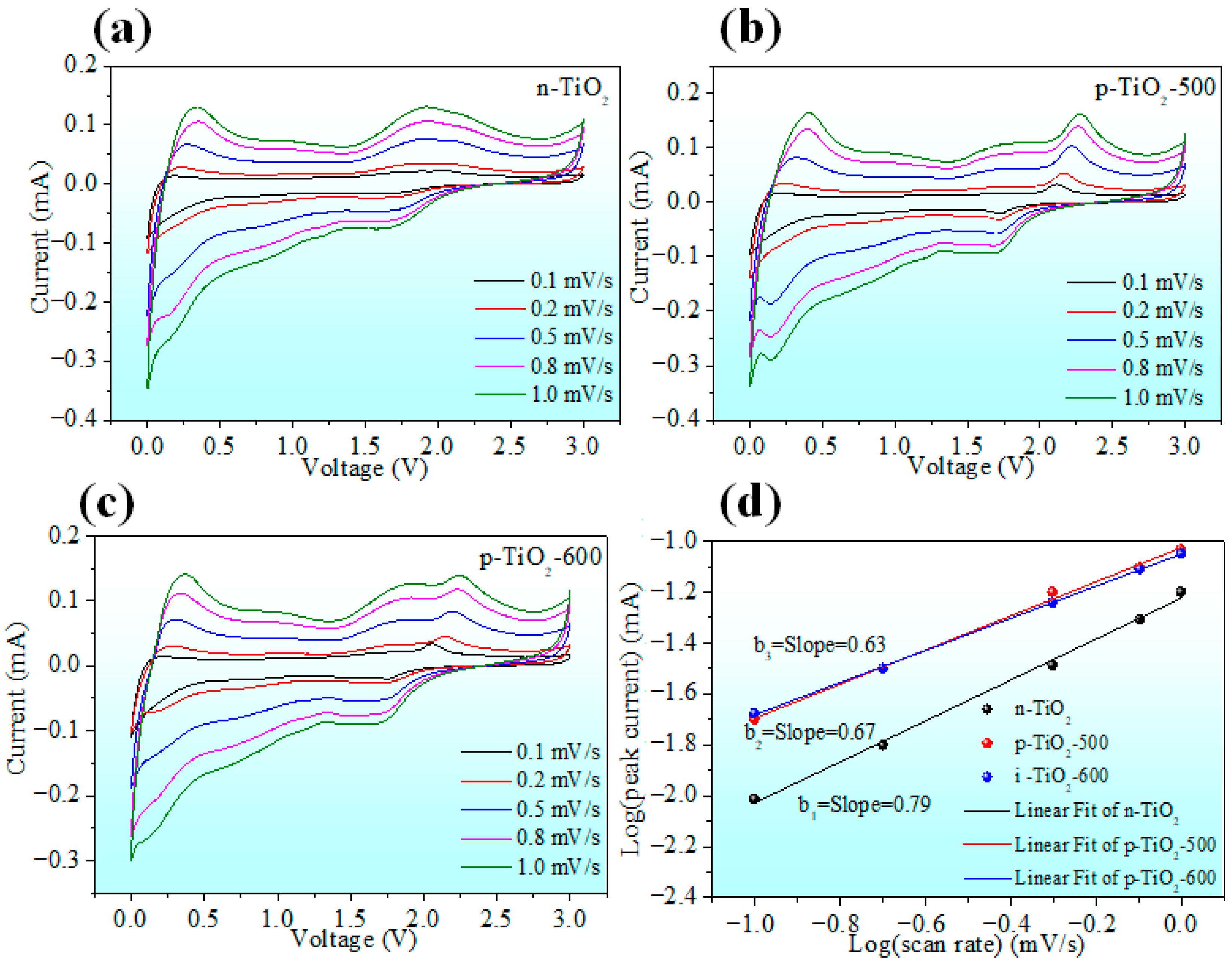

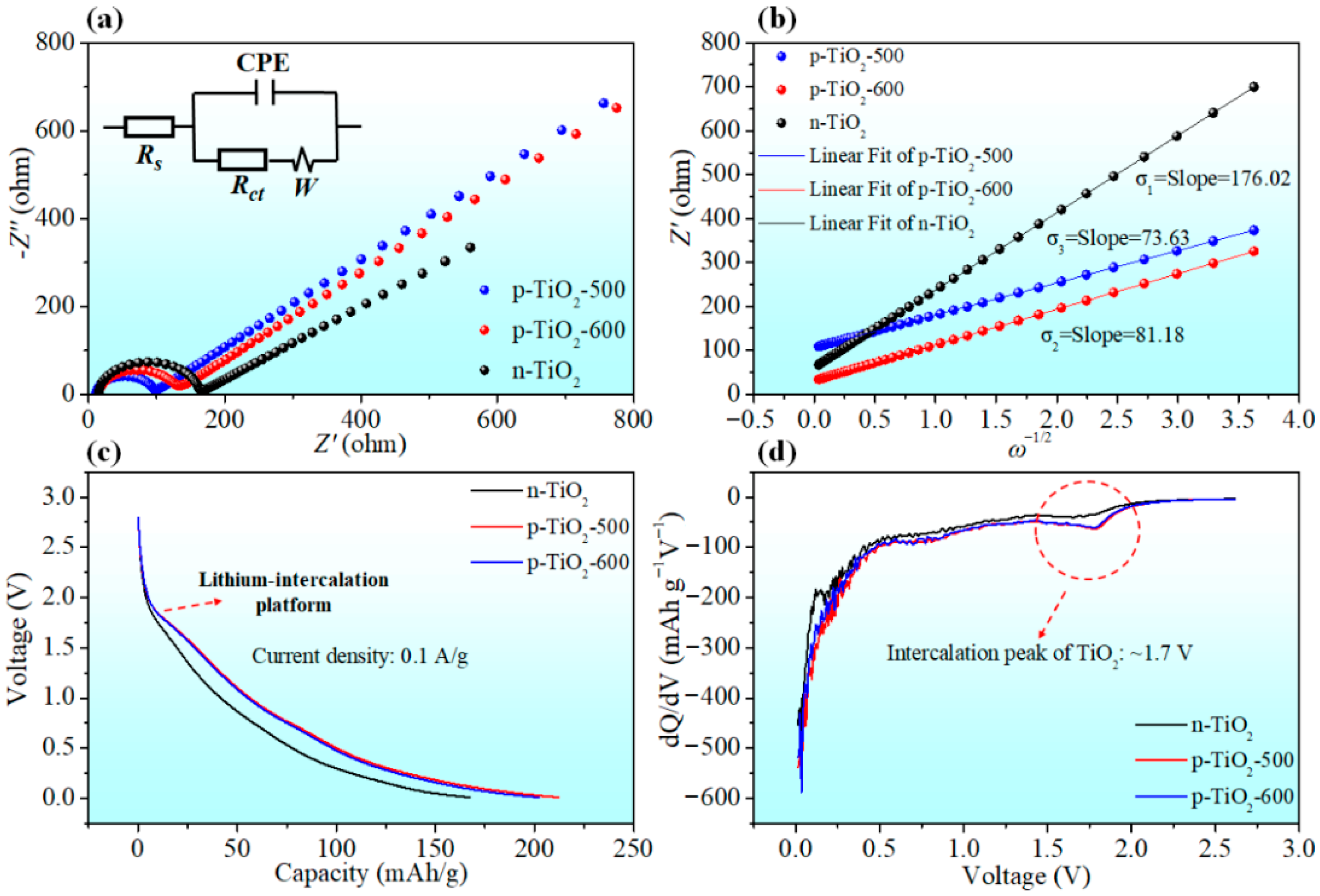
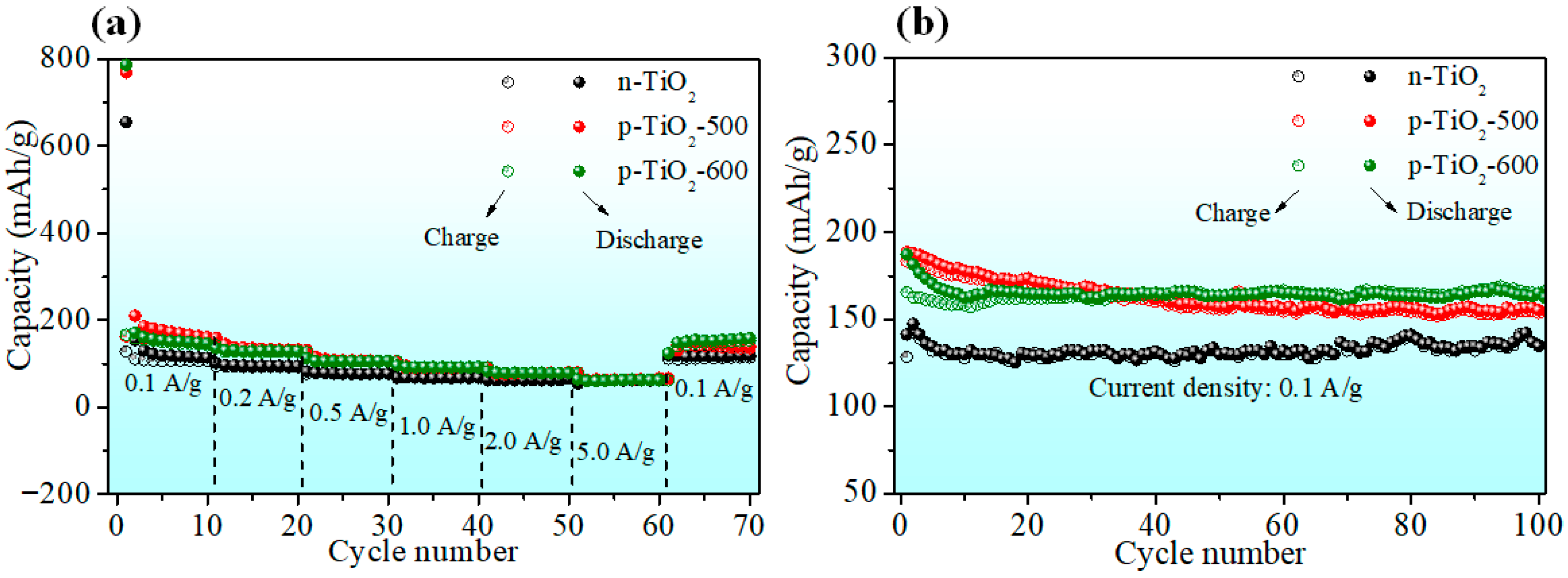
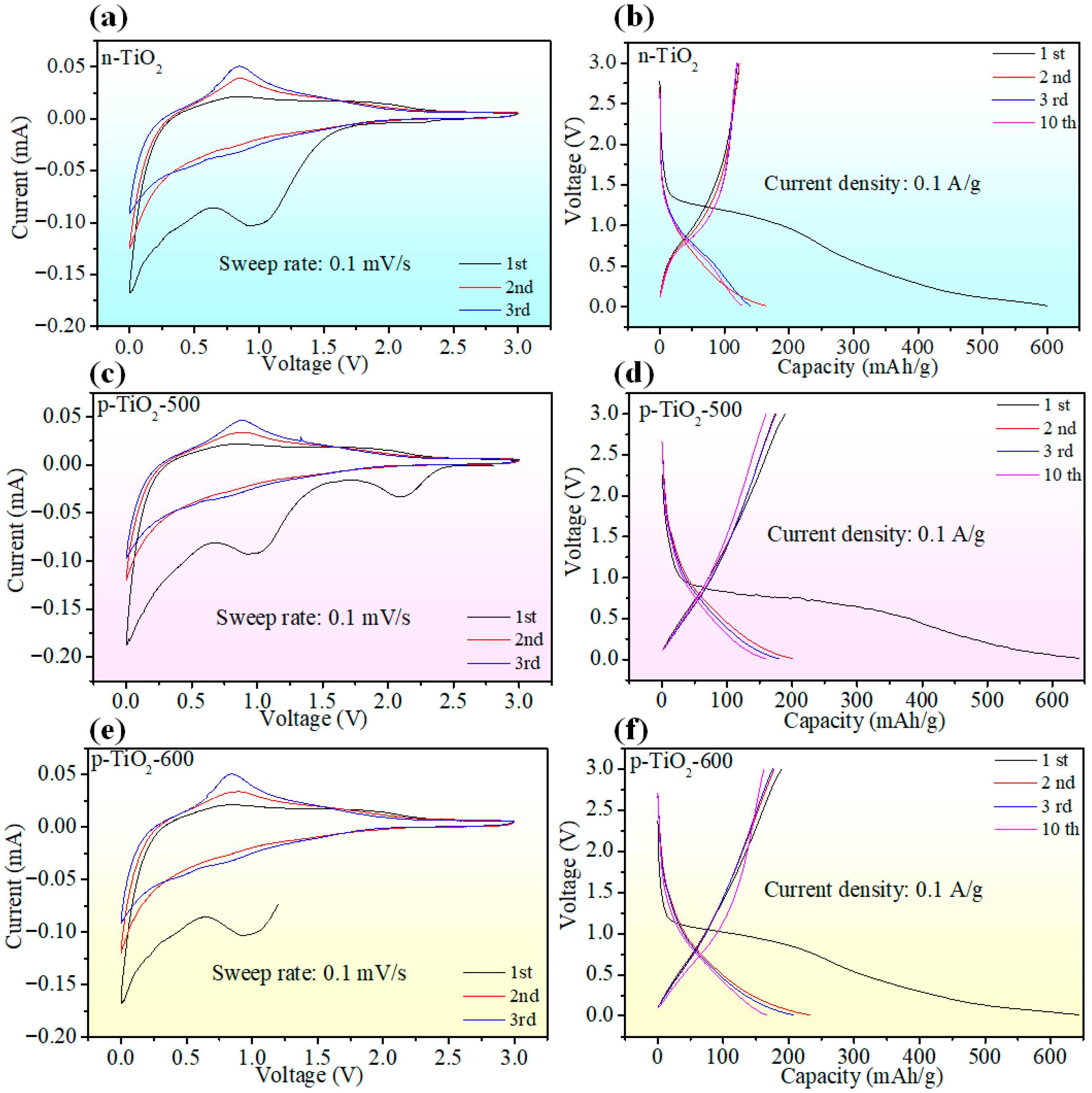
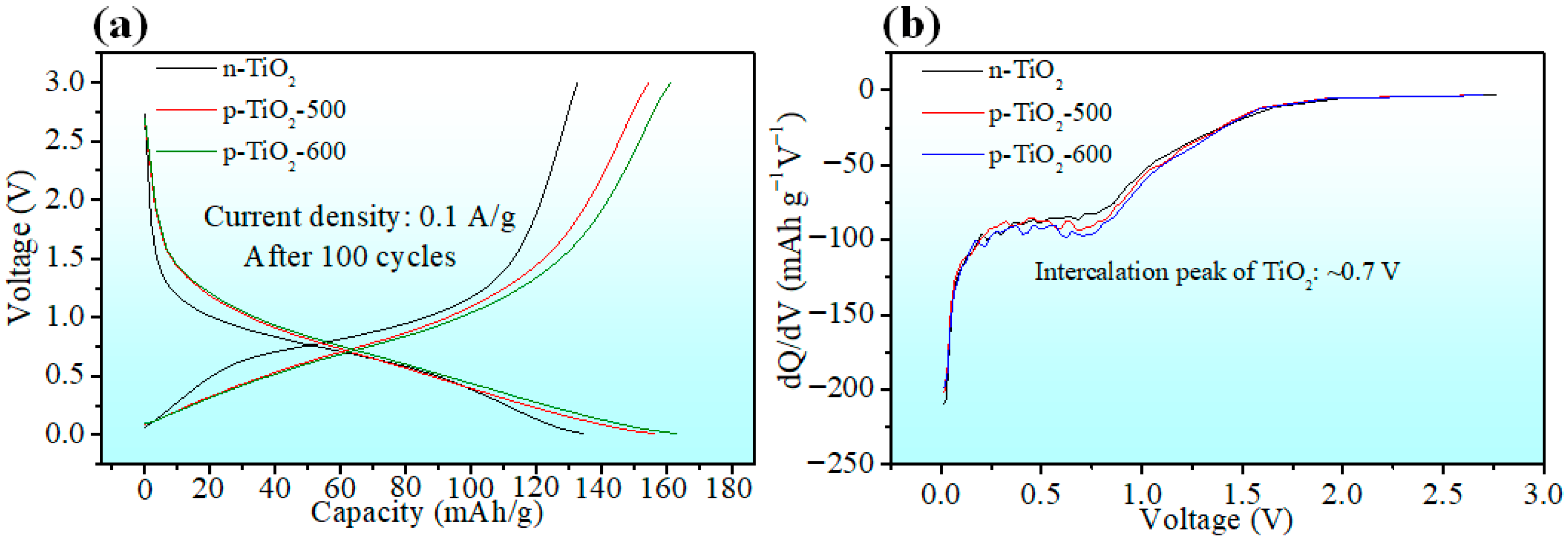
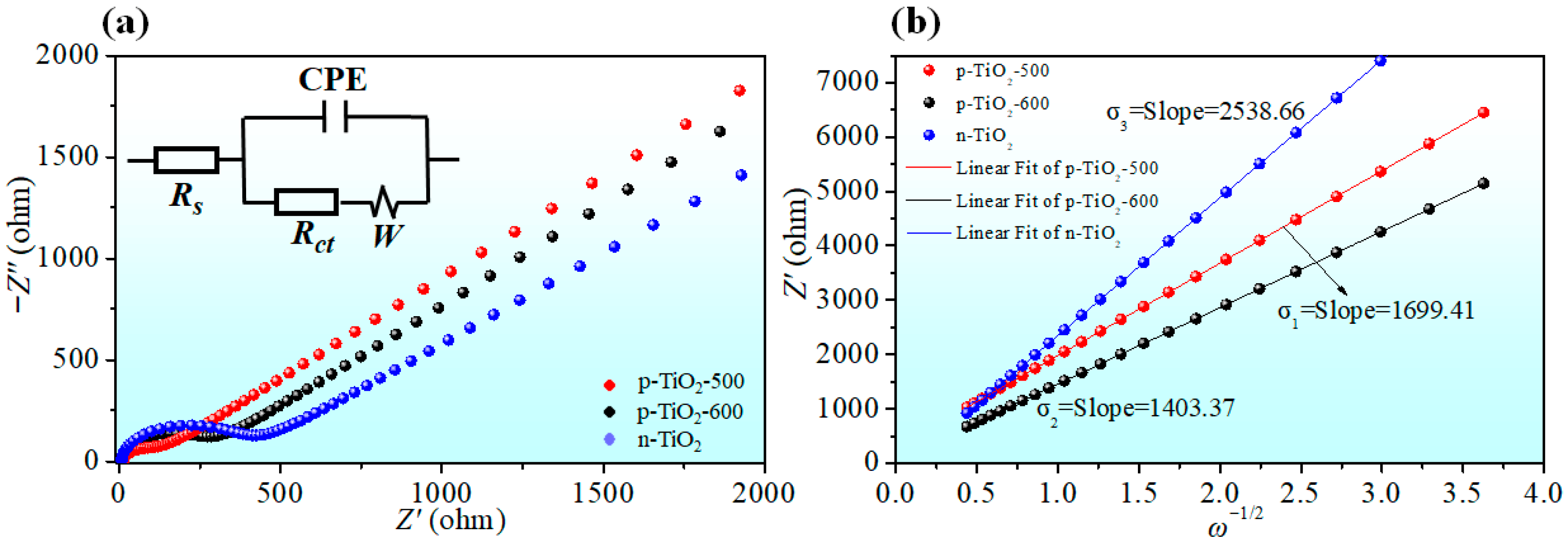
| Material | Discharge/Charge | The Capacity (mAh/g) at Current Density (A/g) of: | ||||||
|---|---|---|---|---|---|---|---|---|
| 0.1 | 0.2 | 0.5 | 1.0 | 2.0 | 5.0 | 0.1 | ||
| p-TiO2-400 | Discharge | 152.3 | 122.1 | 92.3 | 76.9 | 66.7 | 54.2 | 159.4 |
| Charge | 154.2 | 122.1 | 92.3 | 76.9 | 66.7 | 54.2 | 159.4 | |
| p-TiO2-500 | Discharge | 228.8 | 196.3 | 153.9 | 127.5 | 101.6 | 70.5 | 226.9 |
| Charge | 234.5 | 201.2 | 155.7 | 127.6 | 101.6 | 70.5 | 228.6 | |
| p-TiO2-600 | Discharge | 208.6 | 178.1 | 149.0 | 126.4 | 109.5 | 87.5 | 217.8 |
| Charge | 212.3 | 178.3 | 149.3 | 126.4 | 109.5 | 87.5 | 218.6 | |
| n-TiO2 | Discharge | 166.6 | 142.3 | 90.2 | 65.6 | 47.6 | 27.7 | 162.0 |
| Charge | 169.2 | 143.9 | 91.6 | 65.8 | 47.6 | 27.7 | 162.2 | |
| Sample | Rs (Ω) | Rct (Ω) | Z′ (Ω) | DLi+ (cm2/s) |
|---|---|---|---|---|
| n-TiO2 | 12.33 | 160.19 | 172.52 | 1.04 × 10−16 |
| p-TiO2-500 | 11.98 | 90.51 | 102.49 | 5.99 × 10−16 |
| p-TiO2-600 | 12.01 | 120.76 | 132.77 | 4.93 × 10−16 |
| Sample | Rs (Ω) | Rct (Ω) | Z′ (Ω) | DNa+ (cm2/s) |
|---|---|---|---|---|
| n-TiO2 | 9.659 | 358.8 | 368.459 | 4.88 × 10−19 |
| p-TiO2-500 | 8.853 | 143.1 | 151.953 | 1.09 × 10−18 |
| p-TiO2-600 | 8.752 | 235.9 | 244.652 | 1.60 × 10−18 |
Disclaimer/Publisher’s Note: The statements, opinions and data contained in all publications are solely those of the individual author(s) and contributor(s) and not of MDPI and/or the editor(s). MDPI and/or the editor(s) disclaim responsibility for any injury to people or property resulting from any ideas, methods, instructions or products referred to in the content. |
© 2025 by the authors. Licensee MDPI, Basel, Switzerland. This article is an open access article distributed under the terms and conditions of the Creative Commons Attribution (CC BY) license (https://creativecommons.org/licenses/by/4.0/).
Share and Cite
Su, Y.; Li, J.; Liu, S.; Luo, S.; Li, Y.; Zhang, S.; Kong, X.; Huang, Q.; Lu, C. H1.07Ti1.73O4-Derived Porous Plate-like TiO2 as High-Performance Bifunctional Anodes for Lithium- and Sodium-Ion Batteries. Energies 2025, 18, 5077. https://doi.org/10.3390/en18195077
Su Y, Li J, Liu S, Luo S, Li Y, Zhang S, Kong X, Huang Q, Lu C. H1.07Ti1.73O4-Derived Porous Plate-like TiO2 as High-Performance Bifunctional Anodes for Lithium- and Sodium-Ion Batteries. Energies. 2025; 18(19):5077. https://doi.org/10.3390/en18195077
Chicago/Turabian StyleSu, Yabei, Juchen Li, Siyuan Liu, Silun Luo, Yuhan Li, Shaowei Zhang, Xingang Kong, Qiaogao Huang, and Chengyi Lu. 2025. "H1.07Ti1.73O4-Derived Porous Plate-like TiO2 as High-Performance Bifunctional Anodes for Lithium- and Sodium-Ion Batteries" Energies 18, no. 19: 5077. https://doi.org/10.3390/en18195077
APA StyleSu, Y., Li, J., Liu, S., Luo, S., Li, Y., Zhang, S., Kong, X., Huang, Q., & Lu, C. (2025). H1.07Ti1.73O4-Derived Porous Plate-like TiO2 as High-Performance Bifunctional Anodes for Lithium- and Sodium-Ion Batteries. Energies, 18(19), 5077. https://doi.org/10.3390/en18195077






